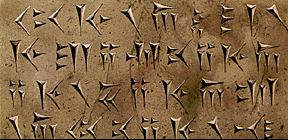This is an illustration of an anachronistic mix of art and script styles of four historic ages.
Initial Idea
Hakuin is one of my most favorite artists of all times. He is one of the most important Zen masters and the author of the koan What is the sound of one hand?
that was significant for my philosophical development. I especially love his calligraphy. On several of his painting he depicted blind people crossing a bridge, which could be seen as a metaphor of the way to enlightenment.
Awakening is mentioned in an eleven centuries older Chinese text used by Tibetan monks in chants.
The background is infused with one of the oldest scripts from Bronze Age, Cuneiform, which influencedthe Tibetan Uchen.
The combination of the two expressive styles of different cultures and times might not be seen as a visual blooper by a modern westerner, but could look ridiculous for a knowledgeable person. I tried to make the fusion harmonious by choosing somewhat similar styles of writing.
On top of everything, I added a text styled to reflect printing scripts popular in 1940-50s.
Arrangement of the Elements
- The oldest script fills the whole surface of the base painting, reddish to match its background. I used "soft light" to blend the layer into the texture and hue of the painting.
- The next oldest Tibetan script is aligned with the bridge, to ground the composition.
- The modern script is at the top right, parallel to the previous two, in order to create some rhythm.
Anachronism - a representation of someone as existing or something as happening in other than chronological, proper, or historical order; an error in respect to dates; any error which implies the misplacing of persons or events in time.
Resources
Hakuin's Painting
18th Century
Hakuin Ekaku 白隠慧鶴 (1686-1769) - Blind Men Crossing a Bridge
Ink on paper, (19.2 x 67 cm), Chikusei Collection.

Sutra in Tibetan Uchen
7th Century
Heart Sutra (China) ending in Uchen script (Tibetan: དབུ་ཅན་), with approximate meaning: gone altogether beyond, oh what an awakening
.

Uchen was developed between in the 7th and 8th century, and has many influences. Thonmi Sambhota was commissioned to create a script for Tibet and Bhutan, which would resemble Indian scripts, so it has aesthetic similarities with Brahami Indian scripts.
Cuneiform Script

Sumerian Cuneiform, which is one of the earliest documented written languages, dated to be of the Bronze Age. This use of lines to create semi-realist images developed into symbols representing meanings. It influenced Uchen script as well.
The generated Uchen text was published by VisibleMantra.org, and the photograph of the Cuneiform was taken initially from Wikipedia.org.
Informal Roman
This font Infroman.ttf (1252 Latin) was designed by Martin Weir, and copyrighted by Esselte corporation and partially by Microsoft in 1997.

